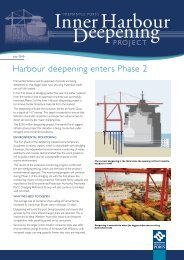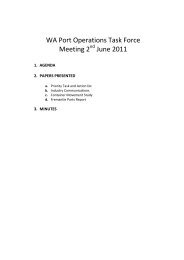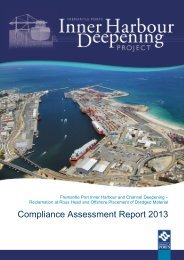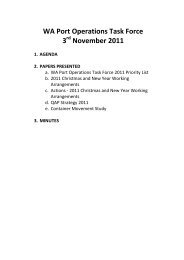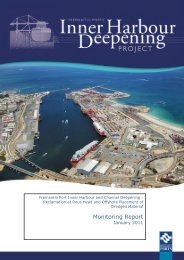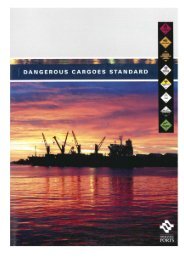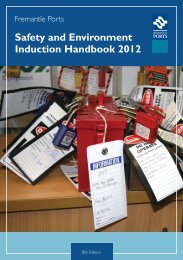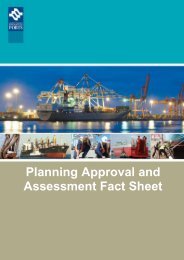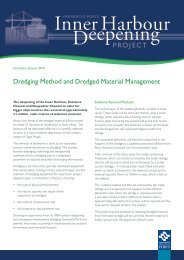Fremantle Port Inner Harbour and Channel ... - Fremantle Ports
Fremantle Port Inner Harbour and Channel ... - Fremantle Ports
Fremantle Port Inner Harbour and Channel ... - Fremantle Ports
- No tags were found...
You also want an ePaper? Increase the reach of your titles
YUMPU automatically turns print PDFs into web optimized ePapers that Google loves.
1. Introduction1.1 BackgroundThe Gage Roads Offshore Disposal Area is located approximately 6 km from the entrance of<strong>Fremantle</strong> <strong>Harbour</strong> in Western Australia (Figure 1.1). The Offshore Disposal Area was utilisedduring 2010 to dispose of approximately 1.5 million m 3 of dredge material associated withthe <strong>Inner</strong> <strong>Harbour</strong> <strong>and</strong> <strong>Channel</strong> Deepening (IHD) Project. The site had not previously beenused as a disposal site, but it is used as an anchoring ground for commercial vessels awaitingcargo at the <strong>Fremantle</strong> <strong>Port</strong> facilities; <strong>and</strong> therefore has a history of seabed disturbance fromanchors.Prior to the IHD Project, it was estimated that approximately 15.4 ha of seagrass habitat waspresent within the Offshore Disposal Area (Figure 1.2) (Oceanica 2010a). Immediatelysurrounding the disposal area, it was estimated that a further 7.9 ha of seagrass habitat waspresent within a predicted zone of potential loss, plus 48.7 ha within a predicted zone ofpotential effect (from sediment deposition <strong>and</strong> light deprivation associated with the offshoredisposal plume from the IHD Project) (Oceanica 2010a).To facilitate an estimate of seagrass loss within the Gage Roads region post-completion of theIHD Project, a benthic habitat map was compiled. However, the actual loss within theOffshore Disposal Area or adjacent area to the south-west could not be confirmed (due to thepresence of an apparent algal bloom preventing visual penetration to the benthicenvironment <strong>and</strong> consequent inability to map habitats) (Oceanica 2010a).Seagrass habitat survey within <strong>and</strong> surrounding the Offshore Disposal Area subsequent to theIHD Project is being undertaken to facilitate seagrass impact assessment particularly toinform future disposal campaigns <strong>and</strong> complete a benthic habitat map for reference.<strong>Fremantle</strong> <strong>Port</strong>s seeks to investigate the rate <strong>and</strong> controlling mechanisms of recovery of theseagrass Posidonia angustifolia (Cambridge <strong>and</strong> Kuo) at the Offshore Disposal Area <strong>and</strong>surrounding areas following disturbance (i.e. from burial, smothering <strong>and</strong> light deprivation).This study will aid <strong>Fremantle</strong> <strong>Port</strong>s' development of a long-term dredge material disposal planthrough a greater underst<strong>and</strong>ing of impacts upon seagrass after disposal of materials <strong>and</strong>through an updated benthic habitat map for the Gage Roads area.1.2 Scope of this documentThis document describes the initial (Phase I) survey of seagrass health, coverage <strong>and</strong>coincident sediment physicochemical data, comprising a 'baseline' for a medium term (up to3 years) investigation into seagrass recovery within <strong>and</strong> around the Gage Roads OffshoreDisposal Area. This document collates relevant historical data <strong>and</strong> outlines methods used forthe Phase I survey, also intended for subsequent surveys, to ensure consistent st<strong>and</strong>ardoperating procedures in the assessment of seagrass recovery.Oceanica: <strong>Fremantle</strong> <strong>Port</strong>s: FP – Gage Roads Offshore Disposal Area Seagrass Recovery Project, Phase I – Initial Survey 1



